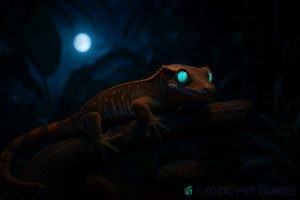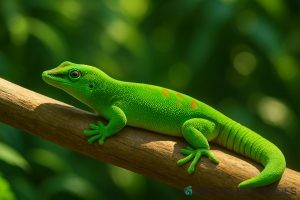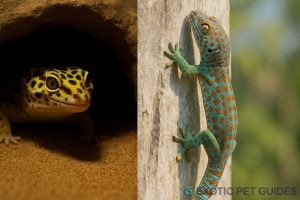Understanding Gecko Activity Patterns and What They Mean for You
When planning to bring a gecko into your home—or simply observing one in the wild—you might ask: Are geckos active during the day or night? The answer isn’t one-size-fits-all. While many geckos are famously nocturnal, there are fascinating exceptions.
Let’s dive into the world of gecko activity patterns and learn what they mean for care, observation, and interaction.

🌌 Most Geckos Are Nocturnal
What Does “Nocturnal” Mean?
Being nocturnal means that an animal is most active at night and rests during the day. Most gecko species fall into this category.
Notable nocturnal geckos include:
- 🟡 Leopard Gecko (Eublepharis macularius)
- 🔵 Tokay Gecko (Gekko gecko)
- 🟤 African Fat-Tailed Gecko (Hemitheconyx caudicinctus)
- 🔴 Gargoyle Gecko (Rhacodactylus auriculatus)
These species have adapted to nighttime activity through:
- Large, light-sensitive eyes with vertical slit pupils
- Camouflage coloration for nighttime concealment
- Silent, stealthy movement to stalk insects in the dark
Their enclosures don’t require bright lighting, and too much daytime activity may signal stress or illness.
🌞 But Some Geckos Are Diurnal
What Does “Diurnal” Mean?
Diurnal animals are active during the day and sleep at night—just like us. A few gecko species have adapted to this lifestyle, often because they evolved in sunlit, arboreal environments.
Day-active geckos include:
- 🟢 Day Geckos (Phelsuma spp.) – like the stunning Madagascar Day Gecko
- 🟢 Lined Day Gecko (Phelsuma lineata)
- 🟢 Gold Dust Day Gecko (Phelsuma laticauda)
Day geckos:
- Have round pupils for better vision in bright light
- Display vivid green, blue, or red coloration for visual communication
- Often bask and forage during daylight hours
- Require UVB lighting to mimic natural sun exposure and synthesize vitamin D3
🌗 Crepuscular Geckos: The In-Betweeners
Some geckos are crepuscular, meaning they’re most active during dawn and dusk—when temperatures are moderate and predators are fewer.
Examples include:
- 🟠 Crested Gecko (Correlophus ciliatus)
- 🟠 Mossy Leaf-Tailed Gecko (Uroplatus sikorae)
These species may occasionally be active during the day or night, but twilight is their prime time.
🔎 Why Does This Matter?
Understanding your gecko’s natural rhythm helps you provide better care and a less stressful environment.
If your gecko is nocturnal:
- Don’t disturb it during the day—let it sleep
- Provide low-level night lighting if you want to observe it (red or blue LED)
- Don’t expect much interaction during daylight hours
If your gecko is diurnal:
- Provide a consistent day/night cycle
- Ensure UVB lighting and basking spots
- Feed during the morning or early afternoon, when they’re most active
⚖️ Tips for Setting the Right Environment
🕯️ Lighting: Use timers to create a 12-hour day/night cycle for both nocturnal and diurnal species.
🌡️ Temperature Gradient: Whether they’re basking in the sun or active at night, geckos need a warm and cool side in their tank to self-regulate.
🕶️ Hides and Shade: Offer plenty of hiding spots for resting, including a moist hide for hydration and shedding.
⏰ Feeding Schedule: Feed based on your gecko’s rhythm—at dusk for nocturnal species, and in the morning for day-active ones.
📌 Final Thoughts
So—are geckos nocturnal or diurnal? The answer depends on the species:
- Most are nocturnal and come alive when the lights go out
- Some are diurnal and thrive in daylight
- Others are crepuscular, active in between
Knowing your gecko’s activity pattern is key to keeping them healthy, stress-free, and thriving in your care.

